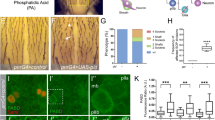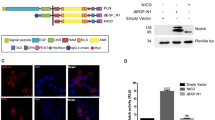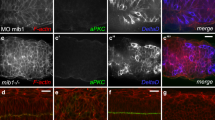Abstract
Cell-fate diversity can be generated by the unequal segregation of the Notch regulator Numb at mitosis in both vertebrates and invertebrates. Whereas the mechanisms underlying unequal inheritance of Numb are understood, how Numb antagonizes Notch has remained unsolved. Live imaging of Notch in sensory organ precursor cells revealed that nuclear Notch is detected at cytokinesis in the daughter cell that does not inherit Numb. Numb and Sanpodo act together to regulate Notch trafficking and establish directional Notch signalling at cytokinesis. We propose that unequal segregation of Numb results in increased endocytosis in one daughter cell, hence asymmetry of Notch at the cytokinetic furrow, directional signalling and binary fate choice.
This is a preview of subscription content, access via your institution
Access options
Subscribe to this journal
Receive 12 print issues and online access
$209.00 per year
only $17.42 per issue
Buy this article
- Purchase on Springer Link
- Instant access to full article PDF
Prices may be subject to local taxes which are calculated during checkout






Similar content being viewed by others
References
Rhyu, M. S., Jan, L. Y. & Jan, Y. N. Asymmetric distribution of numb protein during division of the sensory organ precursor cell confers distinct fates to daughter cells. Cell 76, 477–491 (1994).
Gho, M. & Schweisguth, F. Frizzled signalling controls orientation ofasymmetric sense organ precursor cell divisions in Drosophila. Nature 393, 178–181 (1998).
Kopan, R. & Ilagan, M. X. The canonical Notch signaling pathway: unfolding the activation mechanism. Cell 137, 216–233 (2009).
Wirtz-Peitz, F., Nishimura, T. & Knoblich, J. A. Linking cell cycle to asymmetric division: aurora-A phosphorylates the Par complex to regulate Numb localization. Cell 135, 161–173 (2008).
Knoblich, J. A. Mechanisms of asymmetric stem cell division. Cell 132, 583–597 (2008).
Guo, M., Jan, L. Y. & Jan, Y. N. Control of daughter cell fates during asymmetric division: Interaction of Numb and Notch. Neuron 17, 27–41 (1996).
Berdnik, D., Torok, T., Gonzalez-Gaitan, M. & Knoblich, J. The endocytic protein α-adaptin is required for numb-mediated asymmetric cell division in Drosophila. Dev. Cell 3, 221–231 (2002).
Wakamatsu, Y., Maynard, T. M., Jones, S. U. & Weston, J. A. NUMB localizes in the basal cortex of mitotic avian neuroepithelial cells and modulates neuronal differentiation by binding to NOTCH-1. Neuron 23, 71–81 (1999).
Jory, A. et al. Numb promotes an increase in skeletal muscle progenitor cells in the embryonic somite. Stem Cells 27, 2769–2780 (2009).
Chang, J. T. et al. Asymmetric T lymphocyte division in the initiation of adaptive immune responses. Science 315, 1687–1691 (2007).
Shen, Q., Zhong, W., Jan, Y. N. & Temple, S. Asymmetric Numb distribution is critical for asymmetric cell division of mouse cerebral cortical stem cells and neuroblasts. Development 129, 4843–4853 (2002).
Cayouette, M. & Raff, M. Asymmetric segregation of Numb: a mechanism for neural specification from Drosophila to mammals. Nat. Neurosci. 5, 1265–1269 (2002).
Gulino, A., Di Marcotullio, L. & Screpanti, I. The multiple functions of Numb. Exp. Cell Res 316, 900–906 (2010).
Stylianou, S., Clarke, R. B. & Brennan, K. Aberrant activation of notch signaling in human breast cancer. Cancer Res. 66, 1517–1525 (2006).
Santolini, E. et al. Numb is an endocytic protein. J. Cell Biol. 151, 1345–1352 (2000).
Langevin, J. et al. Lethal giant larvae controls the localization of notch-signaling regulators numb, neuralized, and Sanpodo in Drosophila sensory-organ precursor cells. Curr. Biol. 15, 955–962 (2005).
Roegiers, F., Jan, L. Y. & Jan, Y. N. Regulation of membrane localization of Sanpodo by lethal giant larvae and neuralized in asymmetrically dividing cells of Drosophila sensory organs. Mol. Biol. Cell 16, 3480–3487 (2005).
Hutterer, A. & Knoblich, J. A. Numb and α-Adaptin regulate Sanpodo endocytosis to specify cell fate in Drosophila external sensory organs. EMBO Rep. 6, 836–842 (2005).
Tong, X. et al. Numb independently antagonizes Sanpodo membrane targeting and Notch signaling in Drosophila sensory organ precursor cells. Mol. Biol. Cell 21, 802–810 (2010).
O’Connor-Giles, K. M. et al. Numb inhibits membrane localization of Sanpodo, a four-pass transmembrane protein, to promote asymmetric divisions in Drosophila. Dev. Cell 5, 231–243 (2003).
Babaoglan, A. B. et al. Sanpodo: a context-dependent activator and inhibitor of Notch signaling during asymmetric divisions. Development 136, 4089–4098 (2009).
Ramos, R. G., Grimwade, B. G., Wharton, K. A., Scottgale, T. N. & Artavanis-Tsakonas, S. Physical and functional definition of the Drosophila Notch locus by P element transformation. Genetics 123, 337–348 (1989).
Benhra, N., Vignaux, F., Dussert, A., Schweisguth, F. & Le Borgne, R. Neuralized promotes basal to apical transcytosis of Delta in epithelial cells. Mol. Biol. Cell 21, 2078–2086 (2010).
Struhl, G. & Adachi, A. Nuclear access and action of notch in vivo. Cell 93, 649–660 (1998).
Lecourtois, M. & Schweisguth, F. Indirect evidence for Delta-dependent intracellular processing of notch in Drosophila embryos. Curr. Biol. 8, 771–774 (1998).
Benhra, N. et al. AP-1 Controls the trafficking of Notch and Sanpodo toward E-cadherin junctions in sensory organ precursors. Curr. Biol. 21, 87–95 (2010).
Söderberg, O. et al. Direct observation of individual endogenous protein complexes in situ by proximity ligation. Nat. Methods 3, 995–1000 (2006).
Coumailleau, F., Furthauer, M., Knoblich, J. A. & Gonzalez-Gaitan, M. Directional Delta and Notch trafficking in Sara endosomes during asymmetric cell division. Nature 458, 1051–1055 (2009).
Gomes, J. E., Corado, M. & Schweisguth, F. Van Gogh and Frizzled act redundantly in the Drosophila sensory organ precursor cell to orient its asymmetric division. PLoS One 4, e4485 (2009).
Huang, J., Zhou, W., Dong, W., Watson, A. M. & Hong, Y. Directed, efficient, and versatile modifications of the Drosophila genome by genomic engineering. Proc. Natl Acad. Sci. USA 106, 8284–8289 (2009).
Kiehart, D. P., Galbraith, C. G., Edwards, K. A., Rickoll, W. L. & Montague, R. A. Multiple forces contribute to cell sheet morphogenesis for dorsal closure in Drosophila. J. Cell Biol. 149, 471–490 (2000).
Venken, K. J., He, Y., Hoskins, R. A. & Bellen, H. J. P[acman]: a BAC transgenic platform for targeted insertion of large DNA fragments in D. melanogaster. Science 314, 1747–1751 (2006).
Gervais, L., Claret, S., Januschke, J., Roth, S. & Guichet, A. PIP5K-dependent production of PIP2 sustains microtubule organization to establish polarized transport in the Drosophila oocyte. Development 135, 3829–3838 (2008).
Gho, M., Lecourtois, M., Geraud, G., Posakony, J. W. & Schweisguth, F. Subcellular localization of Suppressor of Hairless in Drosophila sense organ cells during Notch signalling. Development 122, 1673–1682 (1996).
Le Borgne, R. & Schweisguth, F. Unequal segregation of Neuralized biases Notch activation during asymmetric cell division. Dev. Cell 5, 139–148 (2003).
Bellaiche, Y., Gho, M., Kaltschmidt, J. A., Brand, A. H. & Schweisguth, F. Frizzled regulates localization of cell-fate determinants and mitotic spindle rotation during asymmetric cell division. Nat. Cell Biol. 3, 50–57 (2001).
Acknowledgements
We thank O. Baudouin, K. Basler, H. Bellen, R. Bodmer, P. Bryant, S. Eaton, M. Gonzalez-Gaitan, Y. Hong, J. Knoblich, R. Le Borgne, T. Lecuit, Y. Hong, N. Perrimon, F. Roegiers, J. Skeath, R. Ueda, A. Wodarz, W. Zhong, the Bloomington Drosophila Stock Center, the Developmental Studies Hybridoma Bank, the Drosophila Genomics Resource Center and Flybase for flies, antibodies, DNA and other resources. We are very grateful to H. Rouault for the custom design of a temperature-controlled stage. We thank R. Le Borgne, A. Martinez-Arias, O. Pourquié, C. Saleh and laboratory members for discussions and critical reading. This work was funded by the Centre National de la Recherche Scientifique, Institut Pasteur, the National Agency for Research (BLAN-05-0277) and the Fondation pour la Recherche Médicale (DEQ20100318284).
Author information
Authors and Affiliations
Contributions
F.S. designed the study, carried out microscopy work and wrote the manuscript. N.V. generated tagged Notch flies. L.C. carried out all genetic and cell biology experiments and contributed to imaging.
Corresponding authors
Ethics declarations
Competing interests
The authors declare no competing financial interests.
Supplementary information
Supplementary Information
Supplementary Information (PDF 1621 kb)
Supplementary Movie 1
Supplementary Information (MOV 18263 kb)
Supplementary Movie 2
Supplementary Information (MOV 7209 kb)
Supplementary Movie 3
Supplementary Information (MOV 7565 kb)
Supplementary Movie 4
Supplementary Information (MOV 9934 kb)
Rights and permissions
About this article
Cite this article
Couturier, L., Vodovar, N. & Schweisguth, F. Endocytosis by Numb breaks Notch symmetry at cytokinesis. Nat Cell Biol 14, 131–139 (2012). https://doi.org/10.1038/ncb2419
Received:
Accepted:
Published:
Issue Date:
DOI: https://doi.org/10.1038/ncb2419
This article is cited by
-
BM-MSCs overexpressing the Numb enhance the therapeutic effect on cholestatic liver fibrosis by inhibiting the ductular reaction
Stem Cell Research & Therapy (2023)
-
Vacuolin-1 enhances RA-induced differentiation of human myeloblastic leukemia cells: evidence for involvement of a CD11b/FAK/LYN/SLP-76 axis subject to endosomal regulation that drives late differentiation steps
Cell & Bioscience (2022)
-
IL-33 enhances Jagged1 mediated NOTCH1 intracellular domain (NICD) deubiquitination and pathological angiogenesis in proliferative retinopathy
Communications Biology (2022)
-
Hepatic stem cell Numb gene is a potential target of Huang Qi Decoction against cholestatic liver fibrosis
Scientific Reports (2020)
-
Single-cell transcriptome maps of myeloid blood cell lineages in Drosophila
Nature Communications (2020)



